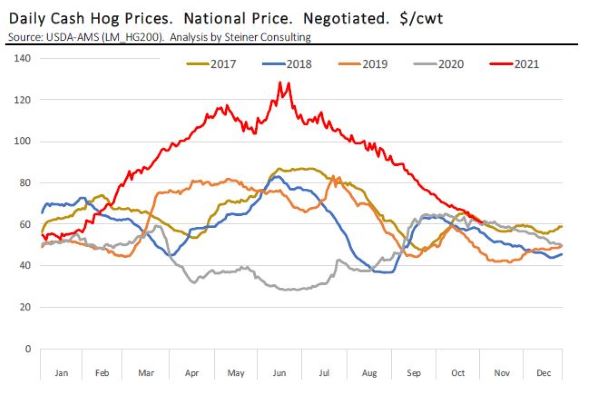MARKET SUMMARY 11-5-2021
Cash hog prices have been the driver in the weakness of the hog futures market. The cash hog trend has been steadily lower since hitting its peak back in June when the market enjoyed multi-year highs in cash prices. As supplies of market hogs seasonally grew and carcass weights have increased, the trend in the cash market has been steadily lower. Earlier this week, the National negotiated cash hog price was $60.98.cwt, the lowest price since early February and only slightly above last year’s cash price. This cash drop has come in the face of overall lower slaughter pace, as estimated slaughter was 2.551 million head, down 5.3% compared to last year. This may be a point soon the market could turn, as slaughter in December is expected to be 6% below last year. With the holiday buying window closing, the market may be shifting back to a focus on export demand and on-going domestic demand.

Like what you’re reading?
Sign up for our free daily TFM Market Updates and stay in the know!
CORN HIGHLIGHTS: Corn futures finished lower for the fourth consecutive session, closing at 5.53 in December, down 6-1/4 cents. On the week, December futures lost 15-1/4 cents after peaking at 5.86 on Tuesday. Sharp losses in soybeans, an increase in farmer selling, and a higher dollar were all viewed as negatives for corn futures. Wheat futures also ended the week in negative territory after strong gains on Monday and Tuesday, helping to add to the negative tone.
This week’s early price rally to new nearby highs and subsequent reversal on Tuesday and follow through selling suggests the market moved high enough to encourage farmer selling. A less than stellar export sales figure and weakness in soybeans added to traders’ sentiment of stepping aside longs. A rally in the dollar didn’t help matters by the end of the week. To date, we would summarize weather for the current planting and growing season in South American as a non-event implying expectations for average to above average first crop corn and on pace for a record second crop as soybean planting is on or ahead of schedule. A weekly hook reversal may not mean much if price hold or recover next week, yet at the of this week it looms large as a possible post-harvest recovery top on Tuesday may have been established.
SOYBEAN HIGHLIGHTS: Soybean futures plunged again in what might be termed a disastrous end of the session and week. On the day, November futures lost 17 cents, closing at 11.92-1/4. For the week, Nov futures gave up 43-1/2 cents to finish at their lowest level since last February. More importantly, overhead resistance held. Good South American crop progress, no weather of major concern, a slower than expected export pace and higher dollar all took their toll on soybean futures this week. Energy prices rebounded today but are still mostly rangebound with crude oil in the low 80s.
Both soymeal and oil were softer today as well. As indicated on previous reports, the perceptive view of more southern Hemisphere production and more acres in the US are keeping traders active selling rallies. Soybeans are at a crossroads. On the one hand, a strong world appetite for protein and oil suggests a firm undertone for prices despite expectations for more world production. On the other hand, supplies are on the rise month to month, and expectations are for record production out of Brazil and more US acres. This implies little reason for end users to book ahead.
WHEAT HIGHLIGHTS: Wheat futures today had moderate losses due to the strength of the US Dollar, spillover from other markets, and technical sell signals. Dec Chicago wheat lost 7-1/4 cents, closing at 7.66-1/2 and July down 5-1/4 at 7.73-3/4. Dec KC wheat lost 7-1/4 cents, closing at 7.78-3/4 and July down 4-3/4 at 7.74.
It was another tough day for the grains with corn, soybeans, and wheat all posting losses. Yet again a firmer start to the day gave way to selling pressure by the close. Though turned negative at the time of writing, a stronger US Dollar this morning weighed on wheat prices and still above the 94 mark continues to take its toll. The wheat market has been trying but unable to find support, given the possibility of a lower US export number but higher Russian prices. South American weather has been mostly favorable with Argentina’s wheat crop rated 46% good to excellent and 10% harvested. Elsewhere weather is a concern. Eastern Australia has been getting perhaps too much rain, causing quality and yield concerns for their wheat crop. Additionally, the developing La Nina pattern could bring dryness to parts of the US next spring and summer, possibly lowering wheat production. US wheat is currently pricey compared to the rest of the world but may become competitive in January. Middle Eastern and North African countries are lacking wheat and need to make purchases. The US ag attaché to India has raised their exports to 5 mmt vs the USDA’s 4 mmt. Paris milling futures had a lower close today but remain near the contract high. Due for release on Tuesday, the USDA’s Supply and Demand report could show less SRW wheat planted due to the wet conditions in the eastern Midwest.
Total Farm Marketing and TFM refer to Stewart-Peterson Group Inc., Stewart-Peterson Inc., and SP Risk Services LLC. Stewart-Peterson Group Inc. is registered with the Commodity Futures Trading Commission (CFTC) as an introducing broker and is a member of the National Futures Association. Stewart-Peterson Inc. is a publishing company. SP Risk Services LLC is an insurance agency. A customer may have relationships with all three companies. TFM Market Updates is a service of Stewart-Peterson Inc. Futures and options trading involve significant risk of loss and may not be suitable for everyone. Therefore, carefully consider whether such trading is suitable for you in light of your financial condition.

